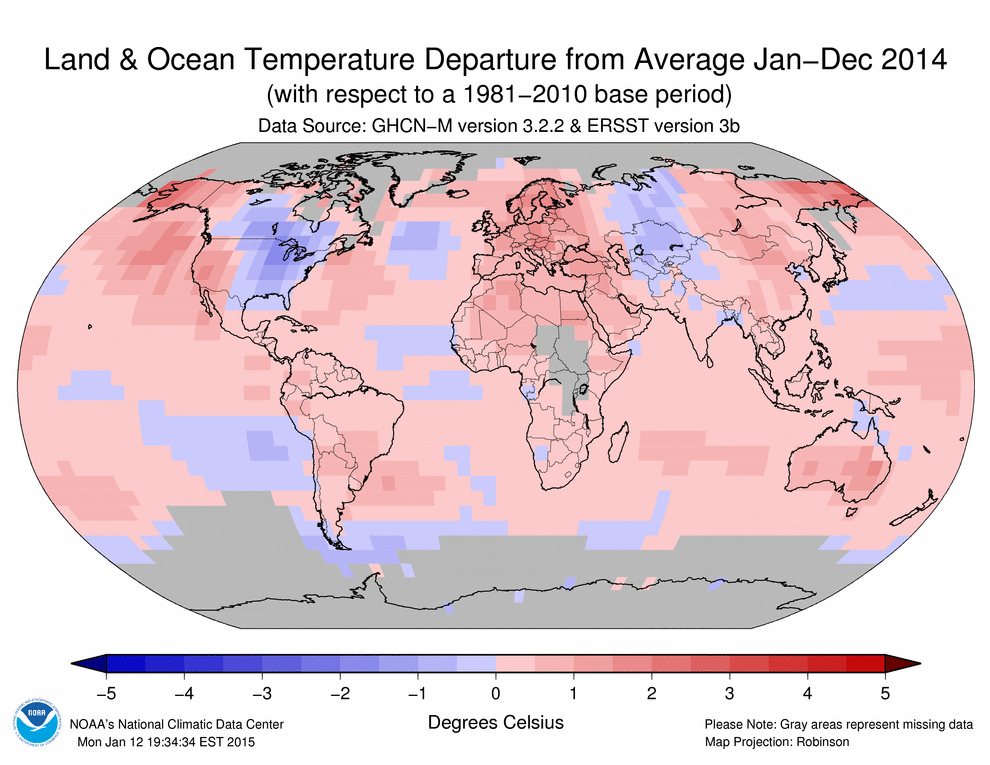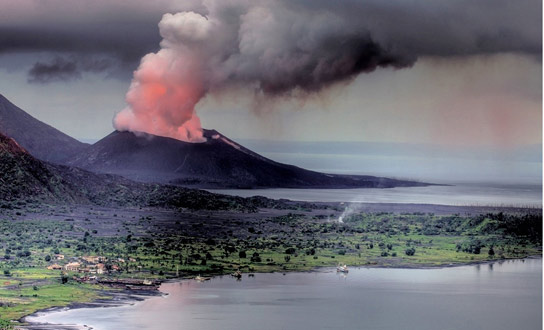January 16, 2015 – Records are made to broken in sports but not in climate. In 2014 we set a dubious new mark. It goes down as the hottest year on our planet since humans started recording weather data on a global level back in 1880.
Yep! We did one better than 2010, the last hottest year on record. For those in Eastern North America who experienced colder than normal temperatures (7 U.S. states recorded a top-10 coldest year), the 2014 record must come as a shock. Obviously it had to be warmer somewhere else. And it was.
The Western United States and Alaska experienced record heat (8 states recorded a top-10 warm year). Australia was blistering hot. So was Central Africa, the Indian Ocean, the northeastern Pacific and Gulf of Alaska, western equatorial Pacific, western North and South Atlantic and the Norwegian and Barents Sea in the Arctic.
But the Atlantic south of Greenland and the southern tip of South America were much colder. Continental Canada experienced its coldest year since 1996 even though its Arctic archipelago experienced warmer than normal temperatures. And one part of Antarctica experienced record cold with sea ice growth exceeding the largest maximum to-date.
Check out the global map below to see where it was hot and where it was cold. The pink to red indicating warmer is far more significant than the blue areas of the planet.
The eastern North America cold we experienced here in Toronto where I live was by no means a record, and scientists suspect the unusual kink in the polar Jet Stream as the cause. Of course that kink which drew cold air from the Arctic into Eastern North America led to record warmth and drought in the American Southwest.
Even more amazing, 2014 wasn’t an El Nino year. The Western Pacific Ocean event that has led to unusually warm years in North America did not occur. In 1998, a record warm year, El Nino played a considerable factor. But since then we have seen 2005, 2010 and 2014 all surpass 1998’s record global temperature without the presence of an El Nino. And now a final statistic: the last year in which temperatures were beneath the 20th century average occurred in 1985. No one born since then has experienced a year that hasn’t been statistically above average in temperature.
I am sure some of you are asking, how do we know 2014 was the hottest year on record? We know because we collect data from climate stations around the planet from the Antarctic to the Arctic, on every continent, on islands dotting the oceans of the world, and from floating ocean buoys equipped with GPS and transmitters. The raw data from these observations is collected and analyzed.
How many stations are used as data collection points? Literally tens of thousands with an average 1,200 new ones being added each year. The ARGO ocean network, literally thousands of floats, records and transmits observed ocean temperatures and salinity with regularity. In some cases the data received for global analysis is found to be biased. For example, a temperature sensor could be faulty creating a false reading. Or a weather station may be improperly positioned so that it receives too much direct sunlight so that the temperatures it records are out of whack. If you don’t believe that this happens observe some billboard thermometers in your travels. Ones in the Sun can be ten degrees warmer than the actual mean temperature. Bad readings get filtered and to further ensure no bias, those calculating global mean temperature err on the side of cooler rather than warmer in the event of such data anomalies.
So here are the results for 2014:
- Average ocean temperature exceeded the 20th century average by 0.57 Celsius (1.03 Fahrenheit) degrees.
- Average land temperature exceeded the 20th century average by 1.00 Celsius (1.8 Fahrenheit) degrees.
- The combined ocean and land temperatures exceeded the 20th century average by 0.69 Celsius (1.24 Fahrenheit) degrees.
- The global average temperature was 14.67 Celsius (58.4 Fahrenheit) degrees.
The global warming skeptics who read this data will invariably point out that although a record in 2014, the temperature rise represents a few hundredths of a degree above the past and therefore within the margin of error. They look at the last decade and see a warming plateau, and no definitive evidence of a growing greenhouse effect.
There has been a plateau of late. What may be the reason? Scientists at Lawrence Livermore National Laboratory have been studying the “warming hiatus” that climate change skeptics point to as evidence that global warming is a hoax. They have discovered that the plateauing may be caused by increased aerosols in the atmosphere. These aren’t aerosols of human creation but are the result of numerous volcanic eruptions over the past decade. A new paper on their finding appeared recently in the journal Geophysical Research Letters. It calculatesthat up to one-third of potential warming has been abated by recent vulcanism.
The research used satellite, ground and air-based measurements to collect data on airborne sulfuric acid droplets in the upper troposphere and lower stratosphere. What the scientists found was a pattern of volcanic signatures not from major eruptions but from continuous small ones that contributed aerosols in enough concentration to reflect sunlight away from Earth producing a cooling effect. One of those eruptions can be seen in the image of Mount Tavurvur in Papua, New Guinea. This eruption may have not made the global headlines, but it is eruptions like this that may be the reason we have experienced a less accelerated greenhouse effect. Not enough, however, to stop 2014 from being the hottest year on record.
Related articles across the web















